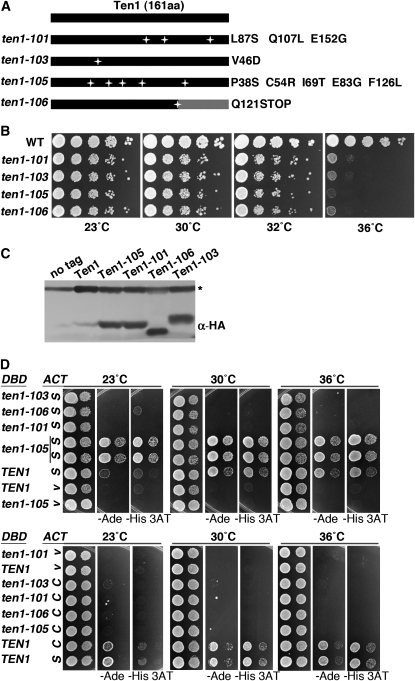Figure 1.—
ten1-ts alleles show progressive telomere elongation at permissive temperature. (A) Diagram of mutations in PCR-generated ten1 alleles. (B) Growth phenotype of ten1-ts alleles. Serial 10-fold dilutions were prepared from equivalent cell concentrations and stamped onto YPD plates. The plates were incubated at the indicated temperatures for 3–4 days. WT (wild-type, hc160), ten1Δ/pTEN1 (hc1832), ten1-101 (hc1862), ten1-103 (hc1863), ten1-105 (hc1864), and ten1-106 (hc1865). (C) Western blot showing expression of Ten1-ts proteins. The Ten1-ts two-hybrid plasmids were transformed into wild-type cells (hc160) and incubated at 30° overnight until the OD600 reached 0.8–1.0. One hundred micrograms of each cell lysate was run on a 10% SDS–PAGE gel, and each HA-Gal4DBD-Ten1-ts fusion protein was detected by anti-HA antibody (12CA5). A cross-reacting band present in the lysates is marked with an asterisk. Strains: No tag (hc160), Ten1 (pCN124), Ten1-101 (pCN445), Ten1-103 (pCN452), Ten1-105 (pCN441), and Ten1-106 (pCN447). (D) Yeast two-hybrid analysis of interaction of Ten1-ts with Stn1 and Cdc13. Ten1 and Ten1-ts proteins were expressed as a Gal4 DNA binding domain fusion (pCN124, pCN441, pCN445, pCN447, and pCN452). STN1 and CDC13 were expressed as Gal4 activation domain fusion proteins (S, pCN181; C, pVL835; V, vector, pACT2.2). An in-frame deletion removes a portion of the Cdc13 DNA binding domain in pVL835 (CDC13Δ585-677). Tenfold serial dilutions of cultures were stamped on SD −Leu −Trp, SD −Leu −Trp −Ade, and SD −Leu −Trp −His +1 mM 3AT plates to examine the expression of the ADE2 and HIS3 reporter genes.

